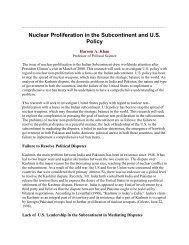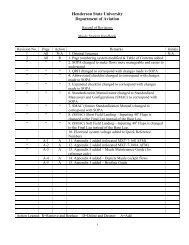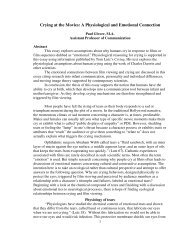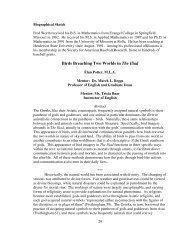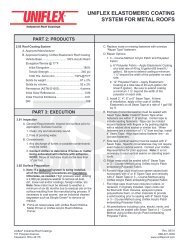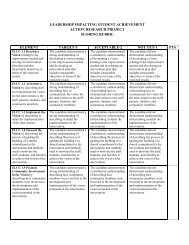Inferential Statistics using the Coefficient of Variation ...
Inferential Statistics using the Coefficient of Variation ...
Inferential Statistics using the Coefficient of Variation ...
Create successful ePaper yourself
Turn your PDF publications into a flip-book with our unique Google optimized e-Paper software.
Academic Forum 26 2008-09<br />
<strong>Inferential</strong> <strong>Statistics</strong> <strong>using</strong> <strong>the</strong> <strong>Coefficient</strong> <strong>of</strong> <strong>Variation</strong><br />
Michael Lloyd, Ph.D.<br />
Pr<strong>of</strong>essor <strong>of</strong> Ma<strong>the</strong>matics<br />
Abstract<br />
Recall that <strong>the</strong> <strong>Coefficient</strong> <strong>of</strong> <strong>Variation</strong> 100/ is<br />
a unit-less measure <strong>of</strong> spread with respect to <strong>the</strong> center<br />
<strong>of</strong> a data set. The distributions <strong>of</strong> <strong>the</strong> standard deviation<br />
and will be derived and statistical inference<br />
involving <strong>the</strong> are discussed.<br />
Consider <strong>the</strong> following example: “A biologist who<br />
studies spiders believes that not only do female green<br />
lynx spiders tend to be longer than <strong>the</strong>ir male<br />
counterparts, but also that <strong>the</strong> lengths <strong>of</strong> <strong>the</strong> female<br />
spiders seem to vary more than those <strong>of</strong> <strong>the</strong> male spiders.<br />
We shall test whe<strong>the</strong>r this latter belief is true.”<br />
Green lynx spider attacking a wasp<br />
Here are data for <strong>the</strong> lengths <strong>of</strong> lynx spiders in millimeters:<br />
Lengths <strong>of</strong> males<br />
5.20 4.70 5.75 7.50 6.45 6.55 4.70 4.80 5.95<br />
5.20 6.35 6.95 5.70 6.20 5.40 6.20 5.85 6.80<br />
5.65 5.50 5.65 5.85 5.75 6.35 5.75 5.95 5.90<br />
7.00 6.10 5.80<br />
Lengths <strong>of</strong> females<br />
8.25 9.95 5.90 7.05 8.45 7.55 9.80 10.80 6.60<br />
7.55 8.10 9.10 6.10 9.30 8.75 7.00 7.80 8.00<br />
9.00 6.30 8.35 8.70 8.00 7.50 9.50 8.30 7.05<br />
8.30 7.95 9.60<br />
We will assume that <strong>the</strong>se are independent<br />
simple random samples, and that <strong>the</strong> shapes<br />
<strong>of</strong> <strong>the</strong> accompanying histograms are<br />
approximately Normal. Thus, we are<br />
justified in applying <strong>the</strong> 2-sample F-test for<br />
comparing standard deviations. The<br />
hypo<strong>the</strong>ses are<br />
H 0 : σ M = σ F and H a : σ M < σ F<br />
where M is <strong>the</strong> male length and F is <strong>the</strong><br />
female length variable, respectively.<br />
The F statistic is s F 2 /s M<br />
2<br />
= 3.21 with a<br />
degrees <strong>of</strong> freedom <strong>of</strong> (29,29) and a p-value<br />
<strong>of</strong> 0.0012.<br />
19
Academic Forum 26 2008-09<br />
The small p-value is evidence that <strong>the</strong> variance in <strong>the</strong> lengths <strong>of</strong> <strong>the</strong> females is greater than that<br />
<strong>of</strong> <strong>the</strong> males. However, doing a 2-sample t-test will provide evidence that female lynx spiders<br />
are longer on average than male lynx spiders. Since <strong>the</strong> female spiders tend to be longer, it<br />
would be more appropriate to compare <strong>the</strong> sex difference in length for <strong>the</strong> lynx spider <strong>using</strong> a<br />
statistic that measures variation relative to length. The coefficient <strong>of</strong> variation is such a statistic<br />
s<br />
and is defined to be CV = 100 . For <strong>the</strong> above data,<br />
x<br />
CV M = 100*.663/5.92 = 11.2 and CV F = 100*1.19/8.15 = 14.6, so CV M < CV F ,<br />
but is this difference significant? We will need to determine <strong>the</strong> distribution <strong>of</strong> <strong>the</strong> CV random<br />
s<br />
variable, so for simplicity <strong>the</strong> 100 in <strong>the</strong> formula will be dropped and we redefine CV = .<br />
x<br />
We will assume for <strong>the</strong> remainder <strong>of</strong> this paper that X<br />
1<br />
, X<br />
2,...,<br />
X<br />
n<br />
is a simple random sample<br />
from N ( µ , σ ) where µ > 0.<br />
Recall <strong>the</strong> following <strong>the</strong>orem:<br />
1<br />
Theorem X =<br />
n<br />
n<br />
∑ X j<br />
j=<br />
1<br />
2<br />
( n −1)<br />
S 2<br />
~ χ ( n −1).<br />
2<br />
σ<br />
1 ⎛ σ ⎞<br />
S = ∑ X − X j<br />
are independent, and X ~ N⎜µ,<br />
⎟ and<br />
n −1<br />
j=<br />
1<br />
⎝ n ⎠<br />
n<br />
and ( ) 2<br />
2<br />
We will derive <strong>the</strong> distribution <strong>of</strong> <strong>the</strong> standard deviation. Recall that <strong>the</strong> probability density<br />
function <strong>of</strong> ~ 2 2 2<br />
u e<br />
U χ ( n −1)<br />
is fU<br />
( u)<br />
= , u > 0, n = 2,3,...<br />
. Write<br />
n−1<br />
⎛ n −1⎞<br />
2<br />
Γ⎜<br />
⎟2<br />
⎝ 2 ⎠<br />
S =<br />
2<br />
σ ( n −1)<br />
S<br />
⋅<br />
2<br />
( n −1)<br />
σ<br />
2<br />
=<br />
f ( s)<br />
= f<br />
S<br />
σ<br />
n −1<br />
U<br />
1<br />
=<br />
⎛ n −1⎞<br />
Γ⎜<br />
⎟2<br />
⎝ 2 ⎠<br />
n−2<br />
s<br />
=<br />
⎛ n −1⎞<br />
Γ⎜<br />
⎟2<br />
⎝ 2 ⎠<br />
n−1<br />
2<br />
n−3<br />
2<br />
U<br />
du<br />
( u)<br />
ds<br />
n−3<br />
u<br />
−<br />
. Apply <strong>the</strong> change-<strong>of</strong>-variable technique to obtain<br />
⎡(<br />
n −1)<br />
s<br />
⎢ 2<br />
⎣ σ<br />
2<br />
⎡(<br />
n −1)<br />
⎤<br />
⎢ 2 ⎥<br />
⎣ σ ⎦<br />
⎤<br />
⎥<br />
⎦<br />
n−1<br />
2<br />
n−3<br />
2<br />
⎡ ( n −1)<br />
s<br />
exp⎢−<br />
2<br />
⎣ 2σ<br />
⎡ ( n −1)<br />
s<br />
exp⎢−<br />
2<br />
⎣ 2σ<br />
2<br />
2<br />
⎤<br />
⎥<br />
⎦<br />
d<br />
ds<br />
⎤<br />
⎥,<br />
s > 0<br />
⎦<br />
⎡(<br />
n −1)<br />
s<br />
⎢ 2<br />
⎣ σ<br />
2<br />
⎤<br />
⎥<br />
⎦<br />
20
Academic Forum 26 2008-09<br />
Here are graphs <strong>of</strong> some probability distribution functions for <strong>the</strong> standard deviation and a<br />
formula for its mean and variance:<br />
Graph <strong>of</strong> S pdf for n=2,3,4,5 <strong>using</strong> σ=1<br />
E[<br />
S]<br />
=<br />
⎛ n ⎞<br />
2Γ⎜<br />
⎟<br />
⎝ 2 ⎠<br />
−<br />
σ → σ<br />
⎛ n −1⎞<br />
n −1Γ⎜<br />
⎟<br />
⎝ 2 ⎠<br />
2<br />
⎡ ⎛ n ⎞<br />
⎢ 2Γ⎜<br />
⎟<br />
⎢ ⎝ 2<br />
Var[<br />
S]<br />
= 1 −<br />
⎠<br />
⎢<br />
⎛ n −1⎞<br />
⎢ ( n −1)<br />
Γ⎜<br />
⎟<br />
⎢⎣<br />
⎝ 2 ⎠<br />
2<br />
as n → ∞<br />
⎤<br />
⎥<br />
⎥ 2<br />
σ<br />
⎥<br />
⎥<br />
⎥⎦<br />
Mean and Variance <strong>of</strong> S<br />
→ 0 as n → ∞<br />
To find a formula for <strong>the</strong> distribution <strong>of</strong> <strong>the</strong> CV, consider <strong>the</strong> joint distribution <strong>of</strong> ( X , S)<br />
. By<br />
independence, <strong>the</strong> joint probability density function is<br />
f with support +<br />
R × R . The<br />
probability density function for S was derived earlier, and <strong>the</strong> probability mass function for is<br />
2<br />
n ⎛ n(<br />
x − µ ) ⎞<br />
easily computed to be f X<br />
( x)<br />
= exp<br />
, ∈ R<br />
2<br />
2<br />
⎜−<br />
2<br />
⎟ x . Therefore, <strong>the</strong> cumulative<br />
πσ ⎝ σ ⎠<br />
distribution function for CV is<br />
⎡ S ⎤<br />
FCV<br />
( c)<br />
= P⎢<br />
≤ c⎥<br />
= P[ ( S ≤ cX ) ∩ ( X > 0)<br />
] + P[<br />
X < 0]<br />
⎣ X ⎦<br />
(If n is sufficiently large, <strong>the</strong>n<br />
∞ cx<br />
= f ( x)<br />
f ( s)<br />
dsdx + P[<br />
X < 0], c > 0<br />
P [ CV < 0] ≈ 0.)<br />
∫ ∫<br />
0 0<br />
X<br />
S<br />
f X S<br />
Differentiate <strong>the</strong><br />
cumulative<br />
distribution<br />
function to obtain<br />
<strong>the</strong> probability<br />
density function:<br />
=<br />
∞<br />
∫<br />
0<br />
⎛ n ⎞<br />
= ⎜ ⎟<br />
⎝ π ⎠<br />
c > 0<br />
f<br />
CV<br />
n ⎡ n(<br />
x − µ )<br />
exp⎢−<br />
2<br />
2πσ<br />
⎣ 2σ<br />
1<br />
2<br />
c<br />
n−2<br />
( n −1)<br />
⎛ n −1⎞<br />
n<br />
Γ⎜<br />
⎟σ<br />
2<br />
⎝ 2 ⎠<br />
∞<br />
'<br />
( c)<br />
= FCV<br />
( c)<br />
= ∫ f<br />
n−1<br />
2<br />
n−2<br />
2<br />
2<br />
⎤<br />
⎥<br />
⎦<br />
0<br />
( cx)<br />
X<br />
n−2<br />
⎛ n −1⎞<br />
Γ⎜<br />
⎟2<br />
⎝ 2 ⎠<br />
2<br />
⎡ nµ<br />
⎤<br />
exp⎢<br />
−<br />
2 ⎥<br />
⎣ 2σ<br />
⎦<br />
( x)<br />
f<br />
∞<br />
∫<br />
0<br />
x<br />
n−3<br />
2<br />
x<br />
S<br />
n−1<br />
d(<br />
cx)<br />
( cx)<br />
dx + 0<br />
dc<br />
⎡n<br />
−1⎤<br />
⎢ 2<br />
⎣ σ ⎥<br />
⎦<br />
n−1<br />
2<br />
⎡ ( n −1)(<br />
cx)<br />
exp⎢−<br />
2<br />
⎣ 2σ<br />
2<br />
⎡ ( n −1)<br />
c + n<br />
exp⎢−<br />
x<br />
2<br />
⎣ 2σ<br />
2<br />
2<br />
⎤<br />
⎥dx<br />
⎦<br />
nµ<br />
x ⎤<br />
+ ,<br />
2 ⎥dx<br />
σ ⎦<br />
21
Academic Forum 26 2008-09<br />
For <strong>the</strong> case 2, this formula simplifies to f CV<br />
(c) =<br />
where<br />
erf( z)<br />
=<br />
2<br />
z<br />
∫ − 2<br />
t<br />
e<br />
0<br />
π<br />
system<br />
Derive can find a formula for<br />
small n. Here are graphs <strong>of</strong> <strong>the</strong><br />
CV for n = 2 ,3,4,5; µ = 1; σ = 1.<br />
The areas under <strong>the</strong>se curves are<br />
.921, .958, .977, .987,<br />
respectively. These areas are less<br />
than 1 because µ and n are small<br />
and <strong>the</strong> P [ CV < 0]<br />
term in <strong>the</strong><br />
derivation <strong>of</strong> <strong>the</strong> probability<br />
density function was ignored.<br />
However, note that <strong>the</strong> area under<br />
<strong>the</strong> probability density function<br />
appears to converge to 1 rapidly<br />
as n converges to infinity.<br />
dt . I could not find general formula for all n, but <strong>the</strong> computer algebra<br />
Since it appeared hopeless to find a formula for <strong>the</strong> distribution <strong>of</strong> <strong>the</strong> CV for 30, I<br />
attempted to directly compute <strong>the</strong> probability <strong>using</strong><br />
P[<br />
CV<br />
< CV<br />
. However, both Derive and Maple were unable to compute f M or f F because n=30 was<br />
apparently too large. For example,<br />
M<br />
F<br />
] =<br />
∞ c M<br />
∫ ∫<br />
0 0<br />
f<br />
M<br />
( c<br />
M<br />
) f<br />
F<br />
( c<br />
F<br />
) dc dc<br />
F<br />
M<br />
could not be evaluated. My last approach was to try a simulation which was successful.<br />
One thousand samples <strong>of</strong> size 30 were simulated <strong>using</strong> <strong>the</strong> accompanying TI-nspire program.<br />
The parameters µ M =5.92, σ M =0.663, µ F =8.15, σ F =1.18 were estimated from <strong>the</strong> sample<br />
statistics. Here are <strong>the</strong> histograms for <strong>the</strong> simulated coefficients <strong>of</strong> variation:<br />
22
Academic Forum 26 2008-09<br />
The variable mcv is <strong>the</strong> male CV, and <strong>the</strong><br />
variable fcv is <strong>the</strong> female CV,<br />
respectively. The accompanying diagram<br />
is a typical Law-<strong>of</strong>- Large Numbers graph<br />
showing <strong>the</strong> empirical probability verses<br />
<strong>the</strong> number <strong>of</strong> trials generated <strong>using</strong> <strong>the</strong><br />
above program. This probability estimated<br />
<strong>using</strong> 1000 gives<br />
P [ CV M<br />
< CVF<br />
] ≈ 0.923 . This probability<br />
is less than 0.95, so this provides evidence<br />
that <strong>the</strong> female spider CV does not appear<br />
to be significantly larger than <strong>the</strong> male<br />
spider CV.<br />
23
Academic Forum 26 2008-09<br />
Conclusion<br />
Unless <strong>the</strong> distributions can be modeled with simpler functions, it is impractical to directly do<br />
statistical inference <strong>using</strong> <strong>the</strong> CV. Also, perhaps simulations should not be overlooked as an<br />
important tool.<br />
It appears that <strong>the</strong> mean <strong>of</strong> CV is approximately σ/µ, and its variance approaches zero as n<br />
approaches infinity. Fur<strong>the</strong>r investigation would be to provide rigorous pro<strong>of</strong>s or numerical<br />
evidence for <strong>the</strong>se conjectures.<br />
References<br />
• Probability and Statistical Inference by Hogg and Tanis , 7th edition ©2006 Pearson.<br />
• http://creatures.ifas.ufl.edu/beneficial/green_lynx04.htm<br />
Biography<br />
Michael Lloyd received his B.S in Chemical Engineering in 1984 and accepted a position at<br />
Henderson State University in 1993 after earning his Ph.D. in Ma<strong>the</strong>matics from Kansas State<br />
University. He has presented papers at meetings <strong>of</strong> <strong>the</strong> Academy <strong>of</strong> Economics and Finance,<br />
<strong>the</strong> American Ma<strong>the</strong>matical Society, <strong>the</strong> Arkansas Conference on Teaching, <strong>the</strong> Ma<strong>the</strong>matical<br />
Association <strong>of</strong> America, and <strong>the</strong> Southwest Arkansas Council <strong>of</strong> Teachers <strong>of</strong> Ma<strong>the</strong>matics. He<br />
has also been an AP statistics consultant since 2001 and a member <strong>of</strong> <strong>the</strong> American Statistical<br />
Association.<br />
24




